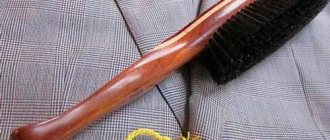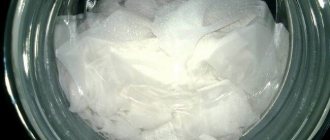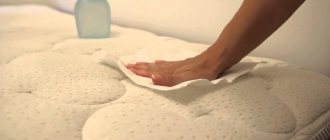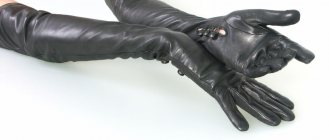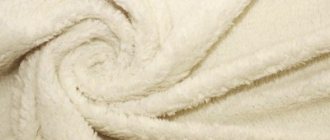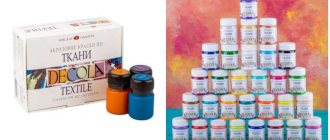Machine wash jackets on a delicate cycle using gel or liquid detergents. Draw warm water 30–35˚С. Avoid twisting and drying in the sun. Dry on hangers and iron through gauze or using a steamer. Use dry cleaning with salt, soda, starch, sand. To remove grime and stains, use rubbing alcohol or ammonia.
Washing jackets: school jackets, suit jackets, women's jackets is a labor-intensive process and requires knowledge of the characteristics of cleaning the fabric from which the product is made. To avoid damaging the item, read the information on the label before washing and use only the washing, cleaning and ironing methods approved by the manufacturer.
Stain removal technique
Before washing your jacket, carefully examine it for stains. Remove dirt using improvised means:
- remove chewing gum from the fabric after freezing the item;
- Wipe stains from paint or corrector with turpentine, thinner or purified gasoline;
- any hair shampoo will help get rid of stains left by natural juices: strawberry, cherry, tomato;
- Remove stubborn oil stains with dishwashing detergent;
- Wipe off coffee marks with a cotton pad soaked in ammonia.
To prevent damage to the jacket, before treating the stained area, test the chosen method on a small strip of the product that is inaccessible to view (on the wrong side or on a special piece of fabric, if one came with the jacket when purchased).
Cleaning items that cannot be washed
Jackets are washed in an automatic machine separately from other items, without using a case.
It is advisable to process them together with trousers if the products are included. Washing at the same time will help avoid uneven fading of items.
Instructions for processing jackets that can be washed in a machine look like this:
Remove foreign objects from pockets. If the pockets are zipped, then they are closed.- They load the jacket into the machine.
Close the door and pour in the minimum amount of detergent. If the dosage is indicated, for example, 80 ml per 5 kg of laundry, then you can take 30-40 ml per jacket. - Set the mode.
To process the jacket, choose a delicate wash at 40 degrees, unless otherwise indicated. If the clothes can be washed by hand, set the appropriate mode without spinning. Can be soaked for 30-50 minutes.
It is recommended to set an additional rinse cycle to remove any remaining powder.
Jackets made of wool and other delicate fabrics can be cleaned by steam or dry cleaning, if machine or hand washing is prohibited.
To remove stains from wool jackets, you can use Luxus Professional - a product designed for cleaning natural carpets. It is applied to a dry cloth and removed with a damp cloth.
If wet processing of a suit is prohibited, and dirt can no longer be removed using a dry method, then it must be sent to dry cleaning. There the jacket is processed using professional equipment and recommended products.
A jacket is the upper part of a suit, used in everyday life, work and social events. Washing at home is necessary to remove unpleasant odors, dirty stains, and settled dust. Proper care will help get rid of oily shine on sleeves, elbows, lapels and collars and extend the wear period.
It is difficult to keep a jacket clean at home; you have to take into account the characteristics of the fabric and the presence of various parts. Some styles have lining, shoulder pads, lapels and padded collars. These details complicate the washing process. You often have to tinker with men's jackets; women's models are simpler and therefore easy to wash.
The type of washing should be selected based on the top material:
- Product made from suit fabric. The material is durable, does not wrinkle, and is wear-resistant. Often, classic versions of suits are made from fabric. You can wash the product at home using dry or wet methods. The most suitable option is to spray the liquid over the surface and brush it. The cleaning solution is prepared from water and ammonia (if desired, it can be replaced with vinegar), mixed in a 4:1 ratio. After cleaning, dry the jacket on hangers at room temperature.
- Leather models. Washing leather products at home is contraindicated. Wet treatment will help get rid of stains and marks. The solution contains water, soap, ammonia. Apply the resulting mixture to the surface with a sponge, remove dirt, and soak the moisture with a dry napkin or cloth. Grease stains can be removed with turpentine or gasoline. Treatment with Vaseline, lemon juice, and egg yolk will help make your skin shiny. It is enough to walk the selected product over the surface.
- At home, you can only wash a wool jacket by hand in slightly warm water. Wool and wool mixtures do not tolerate hot water, it causes deformation. Machine washable if recommended on the model tag. It is better to wash with a liquid detergent; when rinsing it is washed out better. At home, to maintain and prolong the diligent appearance of the jacket, it is recommended to regularly clean it with a brush after use.
- Suede products cannot be washed; they are treated with steam (iron, steam generator), then dirt and dust are removed with a rubber brush. If there are stains, wet treatment of the area is acceptable. Dry horizontally only.
- You can wash your school uniform and jacket at home in a washing machine, if there is permission on the label. Otherwise, choose a wash based on the material and the complexity of the sewing. Dry in a vertical position, hung on a hanger, iron under gauze.
The most contaminated areas are the collar, lapels, sleeves, and pockets. At home, you can wash them using a solution of salt and ammonia mixed in a ratio of 1:6. Processing is done with a sponge. After cleaning, iron until dry.
Dry cleaning
You can add freshness to your jacket at home by dry cleaning. It is possible to refresh a jacket without solutions, which will have a beneficial effect on the material. You can remove dust and dirt with a special adhesive roller (you can use tape) or a clothes brush made of natural bristles. Sometimes it is permissible to use improvised means - salt, sand, starch, soda. Afterwards, dry and ventilate the jacket.
We suggest you familiarize yourself with How to clean an LCD TV screen without streaks
In the shower
At home, you can wash the upper part of the suit in the shower. This is another popular, effective option to get rid of stains and unpleasant odors. Office and school jackets are the most susceptible to contamination. You can remove stains, wash and clean this fabric in the shower. The method is simple but effective.
To do this, place your favorite wardrobe item on a hanger in the shower or above the bathtub. You can use a dry brush to shake off dust and hairs. Moisten the surface with lukewarm water from the shower and brush with a soapy solution, focusing on heavily soiled areas. Rinse off the foam with a shower. Leave to drain and hang to dry. You don't have to iron it.
Be sure to read the label information as not all fabrics will withstand the shower test. Water can ruin the appearance and shape of corduroy, pure wool, and velvet.
You will have to wash the jacket by hand at home if there are contraindications to washing it by machine. To make the washing process easier, it is recommended to first soak the item of clothing in a basin in warm soapy liquid for several hours. You can use washing powder, but a liquid detergent is better, it dissolves and rinses better.
After soaking, use a brush to scrub off areas with obvious traces of contamination. Drain the water and rinse the jacket in clean water, changing it several times. Water should not exceed the temperature mark of 35 degrees. You cannot crush, rub, or squeeze. These actions will damage the material. Place on hangers over a bathtub or basin to drain water.
The final stage is drying the item. A jacket that has been washed by hand should not be wrung out. This action leads to tissue deformation, which is an irreversible process. The item should dry naturally. Most likely, the drying process will be long, it all depends on the fabric of the product, the presence of lining and other large parts. Machine washing is a little easier - a gentle spin mode is used. If there is none, refuse it.
After washing, clothes can be left in the bathroom on hangers or placed horizontally on the dryer. It needs to be given its previous shape, paying attention to the lapels, cuffs and collar. The ideal place for drying is one that is regularly ventilated. The street or balcony is perfect. Drying in the sun is strictly prohibited. The sun's rays will ruin the color of the fabric.
As soon as the jacket has dried and become damp, it needs to be ironed. Before doing this, it would be useful to review the information on the label again - many types of materials are prohibited from ironing at high temperatures. Sometimes when using a regular iron, shiny spots appear; to prevent them, use a cotton cloth or gauze.
Sometimes, for various reasons, it is not possible to iron a jacket while it is wet. In this case, the iron uses the steam mode. In most cases, the fabric shrinks during washing. The steaming process helps it stretch a little.
Vertical steamer
Another option for ironing a suit is a vertical steamer with a large container for liquid. This method is recognized as the best. The steamer allows you to get rid of all the wrinkles that have formed, while the damage to the fabric is minimized. Since the treatment is carried out with steam, even a completely dry jacket becomes damp. Before you put it on or put it away in the closet, the jacket must be completely dry, otherwise new wrinkles are inevitable.
Many people may think that washing such products is a very difficult process. Indeed, if there is no label on the clothing, and it is impossible to accurately determine the fabric, then going to dry cleaning would be a good option. Professionals work there, and washing is done using professional equipment. In such conditions, the jacket will not lose its original appearance.
If you follow these recommendations, the jacket after washing will look like it was just purchased. By doing laundry at home, a person saves on dry cleaning services. Housewives will attribute this fact to the advantages of home washing, despite the fact that the process takes considerable time.
To extend the life of the product, you need to know how to wash your jacket correctly. Despite the fact that such items are made from durable suit fabrics, there are several nuances to cleaning them that will help with washing.
- Never wash it in hot water, otherwise it may become deformed and damaged.
- To dry the product, use a hanger. Thanks to this, there will be no wrinkled or elongated areas.
- Can a linen jacket be washed in a washing machine? Yes, such material is unpretentious. It can withstand high temperatures. If necessary, you can even boil it.
- Woolen items are not suitable for machine washing as they may fade and become deformed. Also, a thing often shrinks and decreases in size. It is better to take thin suit items to the dry cleaner. Experienced experts will find the most optimal solution for removing dirt without damaging the item.
Machine washable
Washing a jacket in a washing machine
Wash out stains. Treat worn and greasy areas with an aqueous solution of ammonia or a mixture of medical alcohol and ammonia.
When choosing a detergent, choose liquids: gels, capsules, liquid powder or soap. A small amount of fabric softener helps with ironing the item.
Set the washing mode to gentle. Delicate wash is optimal, hand wash is an option. The temperature during washing should not exceed 40˚C. Turn off spin or select minimum speed.
We use the shower
If the jacket has to be washed frequently, this can cause it to lose its appearance and stretch. To prevent this from happening, you can wash it in the shower; you will get a fairly gentle washing cycle.
Follow the recommendations provided and everything will work out:
- shake off dust from the product;
- hang it on a hanger in the shower or bathtub;
- turn on warm water, it should not be hot;
- pour the jacket on both sides;
- prepare a cleaning solution using a detergent suitable for the type of fabric;
- moisten a soft brush in the prepared solution and treat the item with it;
- pay special attention to very dirty places;
- turn on the water and rinse off the detergent;
- do not remove clothes from hangers or twist them, let them dry in the same form as they were washed;
- There is no need to iron the product after such washing, unless it remains too wrinkled.
Hand wash
If the product is not machine washable, it will have to be washed by hand.
Hand wash jacket
Before washing your jacket, leave it in cool water, adding your chosen liquid detergent to the water in advance.
Important! Jackets made of delicate fabric should not be soaked.
After an hour after soaking, start washing in slightly warmed water (30–35˚C). You should not rub or twist vigorously, as this will damage the item. Movements should be light and neat.
After washing, take out the jacket, hang it vertically and rinse with plenty of cool running water. Cold water will prevent clothes from shrinking.
Preparation
Proper preparation means avoiding problems at the end of the process. Check your pockets first. Even if there is nothing valuable there, the remains of forgotten pieces of paper will become limp and at the end of the day the entire washed item will be in white shreds, so take everything out completely.
Greasy parts of clothing include elbows, cuffs, collar and pockets. Before machine or hand washing, you need to additionally treat with detergent. It is applied to the stain and left for an hour, after which further washing is carried out. Ammonia is used for these purposes, but it is not suitable for all types of fabrics - before use, check it on an inconspicuous area of the item (for example, on seam allowances).
Features of drying and ironing
Drying and ironing the washed item plays an important role.
How to iron a jacket correctly
This determines whether the jacket will retain its shape and aesthetic appearance.
Since the jacket is a delicate item and cannot be wrung out, drying will take a long time. Dry properly on hangers or horizontally at room temperature.
Note! Drying outside is allowed, but you should avoid exposure to sunlight to protect the item from fading.
When the jacket is slightly dry, begin ironing. Place cotton or gauze cloth between the fabric and the iron. This will prevent stains from forming on the material.
A steam iron is used to iron in a vertical position, without touching the item (non-contact).
Dry cleaning
A jacket or cardigan should be cleaned once every 2 weeks. If it is not possible to wash the material, then it would be best to use dry cleaning services. This method has a number of advantages:
- less fabric wear even with frequent processing;
- deep cleaning of all layers;
- No need to waste time doing laundry yourself.
The main disadvantage is the cost of the service, but a good jacket is also not cheap. It is advisable to have it dry cleaned periodically to preserve the appearance of the item longer.
Dry cleaning
Dry cleaning is a gentle cleaning method.
Cleaning with a sticky roller
No soluble auxiliary substances are required, which significantly saves the product.
With this method, the following equipment is used:
- adhesive roller (you can use tape);
- clothes brush with natural bristles;
- natural ingredients (salt, soda, starch, sand).
After cleaning, you need to dry and ventilate the item.
Always use a special steamer
If you were careless with your favorite wool jacket and didn’t take care of how it was wrinkled, then you can use a steamer. It will help to smooth out even the most complex folds on clothes well and neatly. It is better to keep such fabric away from the iron, as it can damage the shape of the fabric. After a shower, hang such a jacket in the bathroom; the warm steam will help a capricious wool jacket regain its presentable appearance.
Wet cleaning
This is a less gentle but more effective cleaning method. Allows you to get rid of unpleasant odors, dust, and dirt.
Quick cleaning method
Using a spray bottle or a moistened sponge, apply a cleaning agent to the jacket:
- dissolved vinegar or ammonia;
- soapy water;
- special stain remover.
After cleaning, the jacket should be ironed immediately, placing gauze between the iron and the item.
Features of cleaning jackets made from different fabrics
Different fabrics are used to make suits. Therefore, each product requires an individual approach:
- Natural leather should not be cleaned with aggressive substances such as acetone. Remove dirt with water and liquid soap. To add shine, rub your jacket with petroleum jelly, available at the pharmacy.
- Suede cannot be washed. Arm yourself with a brush and suede cleaner. You can also clean it by holding it over steam.
- Linen, cotton and synthetics are washed in an automatic machine, setting the delicate cycle.
- Corduroy and velvet are carefully cleaned with a brush, as they deteriorate from washing.
- Satin tolerates hand washing well.
- Denim is washed at a temperature not exceeding 40 degrees.
Tip: A steamer will help get rid of the smell of sweat, but before using it, read the label, since not all materials tolerate high temperatures well.
Which jackets are best to dry clean?
Wool jackets are easily deformed, become covered with pellets and acquire a specific shine. As a result of washing in a machine, they lose their shape, so they should be dry cleaned. Finicky fabrics also include velvet and suede.
Cleaning a leather product
The skin has strength and elasticity.
Manual wet cleaning only
Washing this material is contraindicated, but wet treatment will help clean the surface of the jacket.
To do this, prepare an aqueous solution containing a copious amount of soap and ammonia. We use a sponge soaked in it to treat the stained areas and dry them with a soft cloth or cotton pads.
Gasoline or turpentine will help remove stubborn greasy stains. It is enough to wipe the necessary areas with a cloth soaked in them.
Advice! To give the leather its former shine, lubricate the jacket with Vaseline, lemon juice or egg yolk.
About the nuances of washing and cleaning suit fabrics
Wool, cotton, linen, cashmere, and suede are used to sew jackets. But often, this is a product made from fabrics of complex composition. In addition to the main one, approximately the same number of additives are used in tailoring a jacket (synthetics, viscose, lycra, etc.).
Additives are an important detail that prevents clothes from losing their shape ahead of time, stretching, creasing, and being subjected to daily ironing. But for the same reason, washing jackets is highly undesirable.
Fabric with a mixed composition may lose its original appearance after washing: stretch out, “sit down,” or both. The only thing left to do is throw away the deformed item. It is advisable to wash (following the operating instructions) only in cases where the product is made from one type of fabric.
The most problematic areas are sleeves, collar, pockets and cuffs. Over time, the elbows begin to “shine” from friction with the surface of the table, the collar begins to shine from contact with the skin of the neck. From daily wear, the jacket gradually becomes saturated with the smell of sweat. The product loses its original chic, and our task is to return it through high-quality cleaning on our own.
Washing a wool jacket
To find out whether wool jackets can be washed in a washing machine, you should read the contents of the label. Often such washing is contraindicated.
Read the label before washing
Woolen and half-woolen items can only be washed by hand and in cold water, since the fabric becomes deformed upon contact with hot water.
To make the item last longer, before each wear you should take time to clean the jacket with a clothes brush. It will remove dust particles and particles of dirt from the fibers, which will allow you to resort to washing less often, which means maintaining the aesthetic appearance of the item longer.
General recommendations
Men's suits are expensive, especially those made to order. Therefore, they require careful handling. The task is complicated by the fact that the jacket has many glued elements, and the lining fabric differs from the main material. Do not panic. First of all, look for the label. The label must contain information regarding washing and ironing. If there is no tag, then you will have to focus on the type of fabric.
If you can’t do without a washing machine, then follow a few important rules:
- Before washing, unzip all zippers on the product;
- instead of regular powder, buy gel or capsules for delicate items;
- place the jacket in a bag (mesh or denser - the more sensitive the fabric, the tighter the protection needed);
- set the temperature no higher than 40 degrees, otherwise the fabric will shrink;
- reduce, or even better, turn off the spin cycle;
- do not use a dryer or the same function in a combination washing machine;
- squeeze on the wire rack, pressing through a towel - without twisting;
- dry, straightening out all the creases, arranging the lapels and lapels correctly, if any, and placing them on hangers.
Advice It is not necessary to wash things after every outing, because there are many ways to give them a neat look.
Recommendations for washing a suede jacket
It is recommended to clean products made of suede or nubuck by heat treatment with steam, then, without waiting for drying, treat with a rubber brush.
Stains can be cleaned with a sponge moistened with ammonia or a solution of a glass of low-fat milk and a teaspoon of soda.
Steam treatment
You can also purchase special products for this fabric - for details, see the material “How to remove greasy stains from suede.”
Dry a suede jacket in a horizontal position.
How to wash a school jacket?
School uniforms should be made from material that can be machine washed. Children's things get dirty more often than adults; stains from food, ballpoint pens and felt-tip pens constantly appear on them. Crepe is best suited for school jackets: this fabric does not cause allergies, it is tear-resistant, the fibers are dense, and do not suffer even from aggressive bleaches and stain removers.
Washing a school crepe jacket at home is very easy. If there are stubborn stains, apply detergent to them, scrub well with a brush (or a hard one) and leave for an hour. After this, you can put the product in the machine and wash it on the “synthetic” mode. This mode alternates low and high speeds, which effectively removes dirt.
It is better to dry the uniform on hangers or horizontally; you can iron it through a piece of cotton fabric.
Cleaning the collar and lapels
To clean one of the most contaminated areas of the product, you can use one of the following methods:
- Dissolve salt and ammonia in a ratio of 1:6. We wet the sponge and treat the collar.
- We dilute ammonia in water in a ratio of 1:3. Use the resulting mixture to wipe off any dirt. Wipe the treatment area with a cotton pad soaked in heated water.
- Clean the required surface with a disc soaked in vodka or medical alcohol. Then iron until completely dry.
Material on the topic: How to clean greasy stains on a down jacket.
How to remove a stain from a suit
To remove a stain without a trace, you need to correctly determine its origin and fabric composition.
Begin removing dirt by shaking out and cleaning. Before applying the stain remover to clothing, check the interaction of the solution and the material in an inconspicuous place. If the stain is small, you can apply the product using a pipette.
- To remove a fresh grease stain, sprinkle it with salt and rub lightly. The procedure is repeated several times until the contamination disappears. Oily traces can be removed from a silk product with salt diluted in an ammonia solution.
- Before removing traces of soot, the dirty area is degreased, then treated with pine turpentine and blotted with a soft cloth. Then rub the stain with a brush and soapy water and wash with warm water. In case of severe contamination, replace the powder with egg yolk.
- To remove traces of fruits and berries, use hot milk or water, as well as a solution of hydrogen peroxide. Dissolve 5 ml of hydrogen peroxide in 100 ml of water, treat the stain and wash off in cold water.
- Rust is removed by treating the dirty area with a cotton swab dipped in a 10% solution of tartaric or citric acid. Then rinse with cold water.
- There are several recipes for removing traces of iodine:
- Using a solution of ascorbic acid. To do this, take 5 ml of warm water (1 tsp) and dissolve a vitamin C tablet in it, apply it to the dirty area. After a few minutes, not a trace remains of the stain.
- In case of significant contamination, the amount of ingredients is increased. Using alcohol or milk. The dirty area is moistened several times, and then the item is washed.
